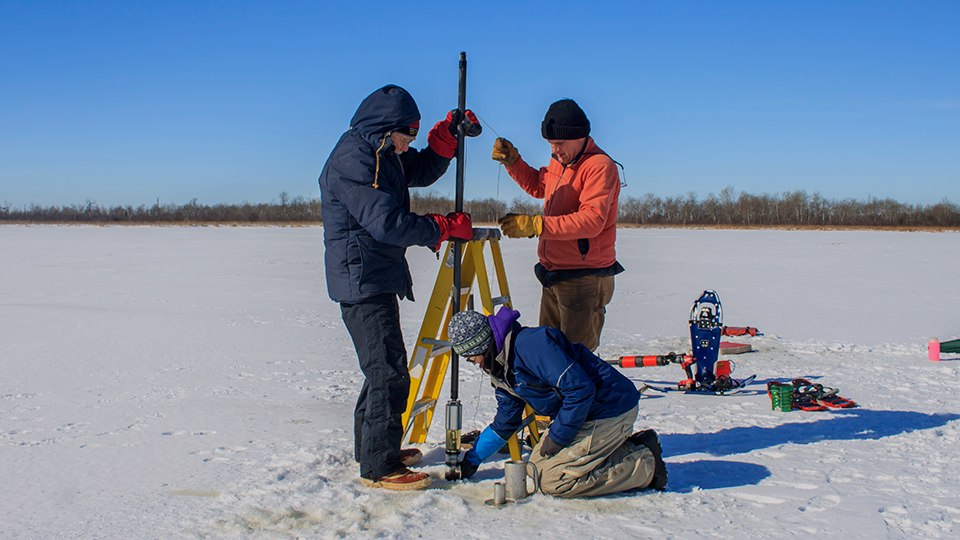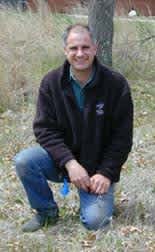
Shawn Schottler
Ph.D. University of Minnesota, Environmental Engineering, 1996
B.S. University of Minnesota, Geotechnical Engineering, 1989
Phone: (651) 433-5953 ext. 18
email: sschottler@smm.org

Research Interests
My principal research studies the impacts of land use on sediment erosion and water quality in agricultural watersheds. I also coordinate and facilitate upland restoration projects conducted on SCWRS lands.
Sediment Fingerprinting
Suspended sediment is a major threat to Midwestern agricultural rivers. Determining sediment sources is critical to allocating management resources. In many rivers it is unclear how much sediment is eroded directly from fields and how much is sloughed from the streambank itself. At SCWRS we are testing a new technique using radionuclides as tracers to determine where suspended sediment comes from by measuring tracer concentrations found in stream-suspended sediment and comparing it to concentrations measured in each of the potential erosion sources. We hope to be able to determine which land use practices create the least amount of sediment erosion.
Upland Restoration
The lower St. Croix forms the transition zone between several major Midwestern habitats. A wide variety of floristic and ecological uplands exist within this area; woodlands, prairie, savanna, and brushlands. Degraded remnants of each of these communities are less than 3% of their presettlement area. Local restoration programs are hampered by size, cost, non-local genetics, lack of plant diversity, and technical training. The SCWRS has initiated the Upland Restoration Alliance (URA) to address these restoration obstacles. Programs include local ecotype seed production, native plantings on SCWRS lands, equipment lending and technical assistance for landowners, restoration techniques, demonstration plots, and research on restoration engineering.
Representative Publications
Schottler, S.P., J. Ulrich, and D.R. Engstrom. (2016) Comment on “Climate and agricultural land use change impacts on streamflow in the upper Midwestern United States” by Satish C. Gupta et al. Water Resources Research 52: 6691-6698.
Hobbs, W.O., Engstrom, D.R., Schottler, S.P., Zimmer, K.D., and Cotner, J.B. (2013). Estimating modern carbon burial rates in lakes using a single sediment sample. Limnol. Oceanogr.: Methods, 11, 316-326.
Schottler, S.P., Ulrich, J., Belmont, P., Moore, R., Lauer,J.W., Engstrom, D.R., and Almendinger, J.E. (2013) Twentieth century agricultural drainage creates more erosive rivers. Hydrological Processes: 11.
Belmont, P., Gran, K. B., Schottler, S.P., Wilcock, P.R., Day, S.S., Jennings, C., Lauer, J.W., Viparelli, E., Engstrom, D.R., and Parker, E. (2011) Large shift in source of fine sediment in the Upper Mississippi River, Environmental Science & Technology 45(20): 8804-8810.
JAMES, T. R., CHIMNEY, M. J., SHARFSTEIN, B., Engstrom, D.R., Schottler, S.P., East, T., and Jin, K.-R. (2008) Hurricane effects on a shallow lake ecosystem, Lake Okeechobee, Florida (USA), Fundamental and Applied Limnology / Archiv für Hydrobiologie, 172, 273-287
SCHOTTLER, S. P. & DEGOLIER, T. (2008) An efficient method for quickly surveying pheasant nesting site preferences, Ecological Restoration, 26, 198-200.
SCHOTTLER, S. P. & DEGOLIER, T. (2008) Influence of floristic diversity on songbird nesting preferences in a suite of adjacent reconstructed grasslands (Wisconsin), Ecological Restoration, 26, 195-198
SCHOTTLER, S. P. & ENGSTROM, D. R. (2006) Chronological assessment of Lake Okeechobee (Florida) sediments using multiple dating markers, Journal of Paleolimnology, 36, 19-36.
SCHOTTLER, S. P. (2002) Study looks at small mammal populations in restored fields, Grasslands, XII, 4-5.
SWACKHAMER, D. L., SCHOTTLER, S. P. & PEARSON, R. F. (1999) Air-water exchange and mass balance of toxaphene in the Great Lakes, Environmental Science & Technology, 33, 3864-3872.